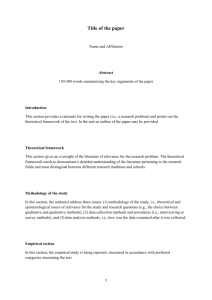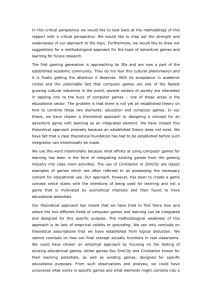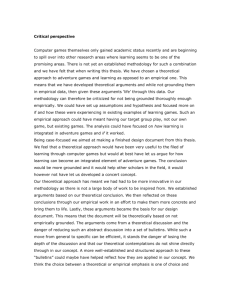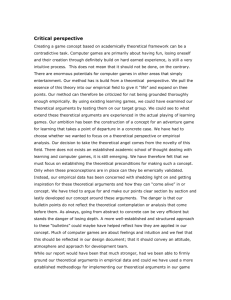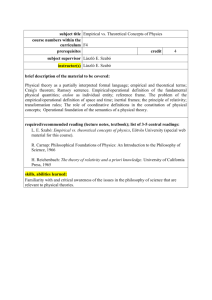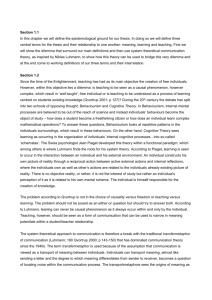2. Methodology
advertisement
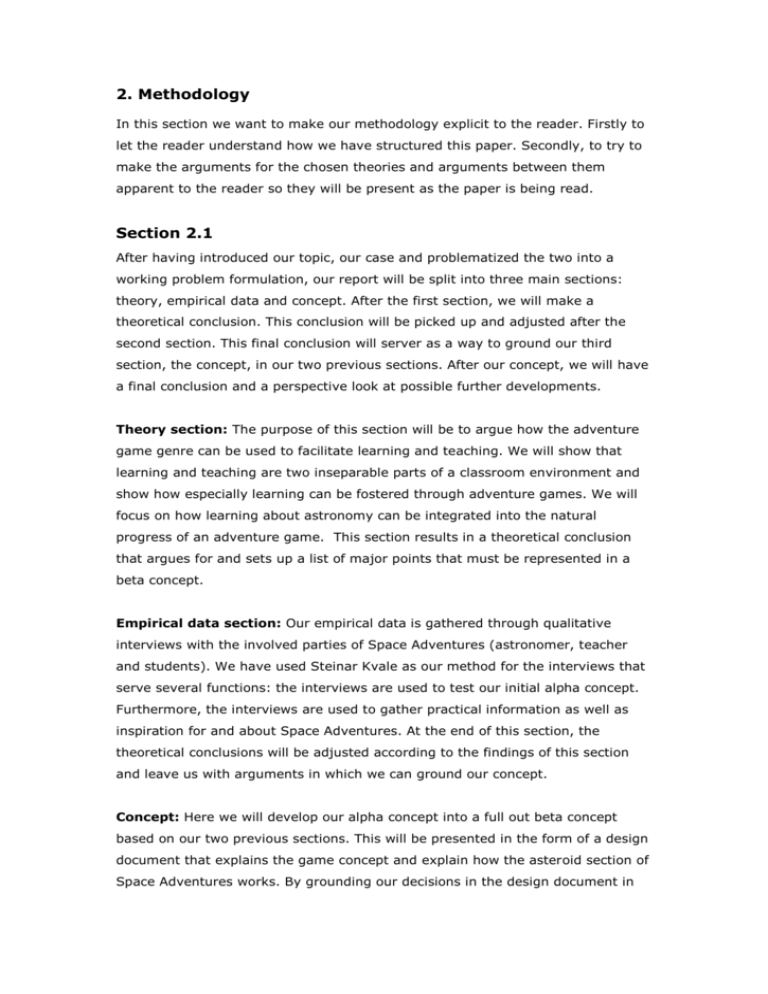
2. Methodology In this section we want to make our methodology explicit to the reader. Firstly to let the reader understand how we have structured this paper. Secondly, to try to make the arguments for the chosen theories and arguments between them apparent to the reader so they will be present as the paper is being read. Section 2.1 After having introduced our topic, our case and problematized the two into a working problem formulation, our report will be split into three main sections: theory, empirical data and concept. After the first section, we will make a theoretical conclusion. This conclusion will be picked up and adjusted after the second section. This final conclusion will server as a way to ground our third section, the concept, in our two previous sections. After our concept, we will have a final conclusion and a perspective look at possible further developments. Theory section: The purpose of this section will be to argue how the adventure game genre can be used to facilitate learning and teaching. We will show that learning and teaching are two inseparable parts of a classroom environment and show how especially learning can be fostered through adventure games. We will focus on how learning about astronomy can be integrated into the natural progress of an adventure game. This section results in a theoretical conclusion that argues for and sets up a list of major points that must be represented in a beta concept. Empirical data section: Our empirical data is gathered through qualitative interviews with the involved parties of Space Adventures (astronomer, teacher and students). We have used Steinar Kvale as our method for the interviews that serve several functions: the interviews are used to test our initial alpha concept. Furthermore, the interviews are used to gather practical information as well as inspiration for and about Space Adventures. At the end of this section, the theoretical conclusions will be adjusted according to the findings of this section and leave us with arguments in which we can ground our concept. Concept: Here we will develop our alpha concept into a full out beta concept based on our two previous sections. This will be presented in the form of a design document that explains the game concept and explain how the asteroid section of Space Adventures works. By grounding our decisions in the design document in our previous conclusions, we will attempt to make an academic argument for our game design. Section 2.2 From system theory to adventure games We have chosen to approach our topic through a system theoretical point of view. There are several different epistemological foundations on which to base a paper like ours. We have primarily chosen system theory because it lets us understand learning and teaching as to separate systems – two systems that are necessarily present in a classroom. In this way we can show how Space Adventures facilitates both the learning and teaching process. We will use System theory as presented by Niklas Luhmann, who wished to accomplish nothing less than a universal theory to describe modern society. The theory describes modern society reduces complexity through communication and reflection. To describe such a complex and dynamic society, the theory itself becomes complex and dynamic. This strength is also the theories weakness as one easily becomes bogged down in the interconnected and abstract theory. We have tried to stay focused on the topics of learning and teaching in our discussion of system theory and thereby avoid getting bogged down in theoretical questions which are interesting but do not pertain to our problem formulation. The system theoretical approach we present in chapter XX is inspired by parts of the system theoretical epistemological and communicative theory as presented by Niklas Luhmann in “Socail Systems” (Luhmann 19??). To supplement this understanding we have used two books by Lars Qvortrup, multimedia professor at Syddansk University. These books are “Det Lærende Samfund” (Qvortrup 2000) and “Det Hyperkomplekse Samfund” (Qvortrup 199?). We have used this literature to give a system theoretical perspective on the following terms: system/environment, mental/social systems, learning, teaching, perturbation, communicative selections, complexity, structural tilkobling and egen compleksitet. In chapter XX we focus on learning and argue that when a student is not internally motivated to learn, an exterior environment might be created which substitutes for such motivations and that such an environment has especially good possibilities in the form of a computer game. Seymore Papert’s theory of Constructionism is used to argue for how learning is facilitated by the creation of objects in a public space – so called public entities. Both Luhmann and Papert draw on the Swiss physiologist Jean Piaget to explain the nature of learning. Where Luhmann emphasizes the necessary importance of communication (or teaching acoording to system theory) in this process, Papert’s theory of Constructionism focuses on building an object, virtual or physical, to engage the learner in a reflective process of learning. For this reason, Papert is an outspoken advocate of using computers in schools as their digital nature allows for the creation of such virtual public entities. Computer games and learning are an interesting combination because especially younger people are internally motivated to play these games. If the two could be coupled, these people would be motivated to learn! We therefore couple Constructionism with Mihaly Csikszentmihalyi’s theory of Flow. Csikszentmihalyi is a professor and former chairman of the Department of Psychology at the University of Chicago and has devoted his life's work to the study of what makes people truly happy, satisfied and fulfilled – the essence of Flow. By understanding Flow, we want to understand what kind of external environments can provide students with the motivation to engage in the creation of a public entity in the learning process. The last part of our theory section, chapter XX, will be an explanation of the adventure game as a genre. We will try to explain the driving force of an adventure game so Space Adventures can build its learning elements around these concepts. Primarily we will be using literature from the gaming industry itsel, namely Game Architecture and Design by Andrew Rollings and Game Design – Theory & Practice by Richard Rouse. This literature will be supplemented by academic approaches to the adventure genre. While we will attempt to acknowledge the academic discussions taking place within the field of adventure games, our focus will be on what constitutes a good adventure game primarily from the perspective of the gaming industry. Section 2.3 Theoretical conclusion While the three sections will continuously try to draw parallels between one another, this will be the place where the three theories are pitted against each other and we will show how the learning process can be tied in to the progression of an adventure game. The chapter will end with a list of bulletins that should be included into Space Adventures in order for it to be an adventure game grounded in learning theories. Section 2.4 The qualitative interview Our empirical data will consist of semi-structured interviews with the astronomer and teacher involved with creating the material for the Asteroid section of the DSRI site. Furthermore we have interviewed an 8th grade class at Brønshøj middle school. Our method for conducting and analyzing these interviews are inspired by Steinar Kvale, a professor and leader of the Center for Qualitative Methoddevlopment. Kvale is primarily interested in using the material from the semi-structured interview to obtain a deeper understanding of and insight into central themes within the lifeworld of the interviewee. This form of analysis can conflict with our system theoretical approach in that the semi-structured analysis strives for an analysis of what and how knowledge and understanding is presented in the interview situation in order to describe the lifeworld of the interviewee. While system theory argues that knowledge and understanding cannot be presented directly through language, we will keep this problem in mind and primarily use the interview to get feedback on our alpha concept, inspiration for further development as well as a way of collecting concrete data in terms of asking direct questions. Section 2.5 Final conclusion After the presentation and analysis of our empirical data, we will revise our theoretical conclusion to reflect the findings of the empirical chapter. The objective is to adjust our theoretical conclusions based on our empirical findings. We will end up with a list of bulletin points which must be included in the design of Space Adventures. These bulletins will give us a way of grounding our concept in our theory and empirical data. While it will never be possible to reduce abstract theory and analysis into a complete check list, our ambition is to have sufficiently argued for these points so that we mostly have to deal with how they are grounded in our list as opposed to why. Section 2.5 Concept

